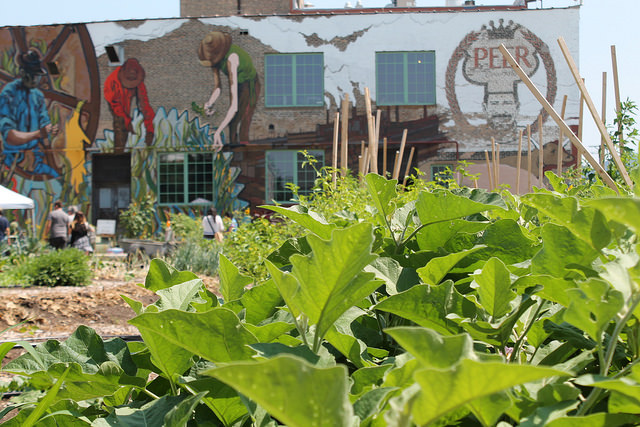
The Plant Creating Sustainable Businesses on South Side
BY ERIKA SALISBURY
Even though I understood the basic premise of The Plant before I got there – a sustainable vertical farm in a re-purposed industrial building – I’ll admit I was a little skeptical as I walked past a few box stores toward the hulking, industrial site on the South Side. Having grown up on a farm, this image was definitely at odds with my idea of gently rolling rural acres, but I was in for a surprise. Initially, I was amazed at how a former meatpacking facility was transformed into a space full of life; from the colorful murals on the walls of the building to the outdoor garden areas with chickens being raised on food waste and the indoor farms and businesses taking shape. I was even more impressed when I learned that the majority of the building renovations were being done using materials carefully salvaged from the original construction.
I realized pretty quickly that The Plant is a lot more than just an urban farm. It’s more like a sustainable neighborhood of organizations located under one roof. The tenants consist of: a bakery, a cheesemaker, a kombucha brewery, an aquaponics farm, a prawn farm and Plant Chicago, the non-profit organization dedicated to promoting sustainability, conservation, and waste reuse through education, research, and development. Future plans call for a garden center and brewery. All of these tenants operate on a model of closing waste, resource, and energy loops. That means the waste from one business becomes a resource for another. A prime example is their aquaponics farm: fish feed on spent barley from the brewery; the fish waste is used to feed the plants growing in hydroponic beds. By absorbing the nitrates, the plants clean the water which can then be returned to the fish.

At the center of The Plant’s closed loop operation is their anaerobic digester. It didn’t take long to understand that this was way more than just a fancy composter. When operational, the digester will consume 27 tons of food waste per day (any waste produced in the facility as well as waste from food producing business all over Chicago) and convert it into three reusable materials. The hummus-like solids can be used to make a green soil blend, the nutrient filled liquid will fertilize the plants, but the star of the show is methane/carbon dioxide gas. Yes, you read that right. The methane will be pumped into a combined heat and power system, which will provide renewable heat and electricity for the building, with the possibility of feeding surplus electricity back into the national grid.

When it’s fully operational, The Plant will create jobs, produce its own sustainable energy, keep more than 10,000 tons of Chicago’s food waste from ending up in landfills each year, provide sustainable, local food in a food desert, and educate Chicagoans on sustainable food production, reusing waste, and creating and conserving energy. If you’re interested in seeing The Plant firsthand (and sampling some of their products), they host a monthly market from 11 a.m. – 2 p.m. the first Saturday of every month followed by a public tour. The market features goods from Plant tenants along with other Chicago businesses. If you’d like to get involved hands on, The Plant also welcomes volunteers. To learn more, check out their website.
If you’re interested in seeing The Plant firsthand (and sampling some of their products), they host a monthly market from 11 a.m. – 2 p.m. the first Saturday of every month followed by a public tour. The market features goods from Plant tenants along with other Chicago businesses. If you’d like to get involved hands on, The Plant also welcomes volunteers. To learn more, check out their website.

